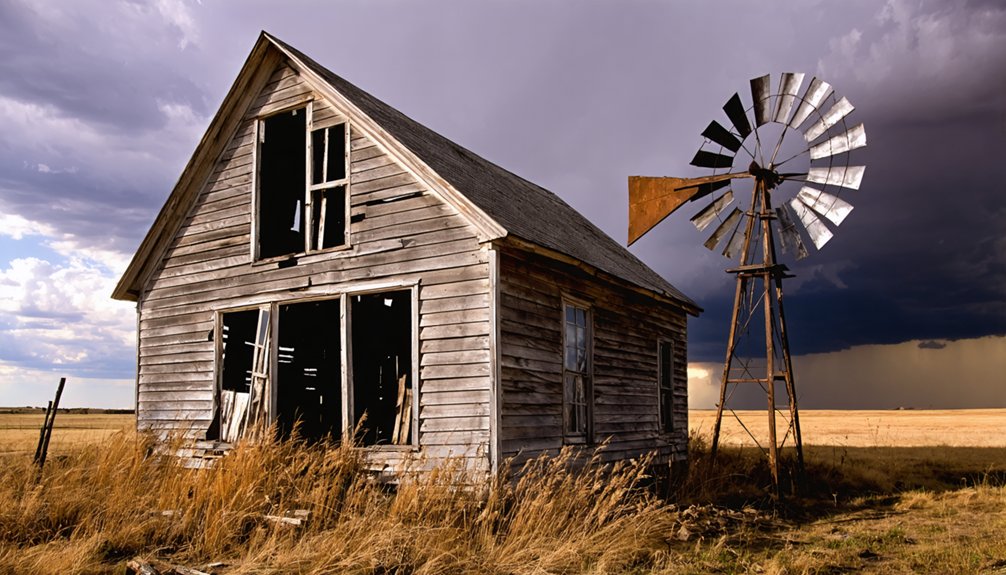You’ll find Luffman nestled in South Dakota’s Black Hills, where a once-bustling community thrived during the Great Dakota Boom of 1878-1887. German and Norwegian settlers built their lives around the local sawmill and railroad depot, with the chapel serving as the heart of social life. After enduring harsh winters, floods, and the sawmill’s closure in 1952, Luffman gradually emptied. Today, scattered foundations, ash heaps, and an aging chapel tell deeper stories of frontier resilience.
Key Takeaways
- Luffman became a ghost town after economic decline triggered by the 1952 sawmill closure and removal of vital railroad connections.
- The abandoned chapel remains the most prominent structure, symbolizing the town’s pioneer spirit and religious community life.
- Established during the Great Dakota Boom (1878-1887), Luffman thrived as a railroad and sawmill town with German-Norwegian heritage.
- Visitors can explore scattered building foundations and ash heaps, but no marked trails or facilities exist at the site.
- Environmental challenges, including harsh winters and droughts, contributed to the town’s abandonment and current ghost town status.
A Boom Town’s Humble Beginnings
While many frontier settlements emerged gradually, Luffman’s story began during the Great Dakota Boom of 1878-1887, when railroads and the promise of fertile farmland drew settlers to the Dakota Territory.
You’ll find that settler motivations centered on the Homestead Act‘s generous land offerings and the region’s reputation for profitable wheat production. The railroad’s aggressive marketing campaigns painted an enticing picture of agricultural prosperity, though settlers soon faced agricultural challenges they hadn’t anticipated. The end of grasshopper plagues helped fuel this wave of settlement optimism. Like many Dakota communities, the town attracted German and Norwegian immigrants seeking new opportunities.
Settlers flocked to the frontier dreaming of free land and agricultural riches, only to discover harsh realities beneath railroad promises.
As speculators and homesteaders rushed to stake their claims, Luffman transformed from open prairie to a budding agricultural community.
The town’s establishment coincided with the expansion of regional flour milling operations, which gave early settlers hope for sustainable economic growth through wheat farming and related commerce.
Life in Early Luffman
You’d find early Luffman settlers spending their days tending crops, caring for livestock, and maintaining their modest sod homes while relying heavily on shared community resources like wells.
The arrival of the railroad in the 1880s transformed daily routines by connecting the isolated farming community to larger markets and bringing new goods, which spurred the construction of more permanent buildings.
Your social life would’ve centered around community gatherings at the local church, harvest celebrations, and cooperative work events like barn raisings, where settlers helped each other survive the harsh Dakota conditions.
Trading interactions at the local general store became a vital part of sustaining the community, providing essential supplies and a central meeting place for residents.
Daily Work and Routines
Life in early Luffman centered around the demanding work of farming and mining, with residents rising before dawn to begin their daily tasks.
You’d find farmers tending to their crops using traditional plows and harrows, implementing crop rotation to maintain the soil’s health. They’d manage their livestock, including cattle and sheep, while battling the challenges of the arid climate through irrigation systems they’d developed.
Similar to Ardmore’s struggles, the community faced ongoing issues with lack of drinking water, which made daily farming operations especially difficult.
If you weren’t working the fields, you’d likely be found in the mines, extracting gold, silver, or copper using manual methods. Like many early Black Hills communities, Luffman’s mining operations developed rapidly after the arrival of placer miners in 1875.
The mining practices were dangerous, with minimal safety measures in place. You’d need to source your equipment from larger towns, and you’d rely on the railroad to transport materials and connect with trading partners in bigger cities.
Community Events and Gatherings
Despite its small size of roughly 100 residents at its peak, Luffman fostered a vibrant community life centered around its iconic chapel.
You’d find the townspeople gathering regularly for religious services, seasonal celebrations, and memorial observances that strengthened community bonds. The chapel served as more than just a place of worship – it became the heart of social connection where families shared music, dancing, and storytelling.
During times of hardship, like the 1919 influenza outbreak or devastating floods, you’d witness the town pull together in remarkable ways. Residents supported each other through informal networks of childcare and elder assistance. Similar to how Galena’s schoolhouse remains today, the chapel served as a central gathering place for community events.
Even today, you can sense this spirit of unity when visiting the chapel ruins and the nearby grave markers that tell stories of shared triumphs and tragedies.
Railroad Connection Impact
When the railroad arrived in southeastern South Dakota during the 1880s, Luffman’s fortunes changed dramatically.
You’d have seen the town transform as freight services connected local farmers and businesses to larger markets, while the depot became the heart of daily life. The strategic placement along railroad routes brought new opportunities, with investors and settlers flocking to capitalize on the town’s promising location.
At the depot, you’d have found yourself among neighbors exchanging news and collecting mail, while telegraph services kept you connected to the wider world. The town’s growth mirrored other Black Hills communities that saw rapid expansion when the first standard gauge railroad reached the region in 1885.
The railroad’s presence spurred rapid development, with grain elevators and warehouses sprouting up along the sidings. For Luffman’s residents, the railway meant more than transportation – it represented their lifeline to commerce, communication, and community growth. Local speculators invested heavily in nearby land, anticipating the economic boom the railroad would bring.
The Sawmill Era and Railroad Days
During its heyday, Luffman’s economic prosperity centered around its bustling sawmill, which processed timber from the surrounding Black Hills region.
You’ll find the sawmill operations were the lifeblood of this small community, employing many of the town’s estimated 100 residents and supporting local businesses like the general store.
The railroad played a vital role in Luffman’s success, connecting the timber processing facility to broader markets.
Multiple rail lines served the town, making it a hub for lumber transportation and attracting workers from across the region.
Like many railroad-influenced towns, Luffman was strategically placed seven miles from neighboring communities to accommodate steam locomotive servicing needs.
When the sawmill finally closed its doors in 1952, you’d have witnessed the town’s rapid decline.
Without its primary employer and with the eventual removal of the railroad lines, Luffman couldn’t sustain itself, leading to an exodus of residents.
Natural Disasters That Shaped Destiny
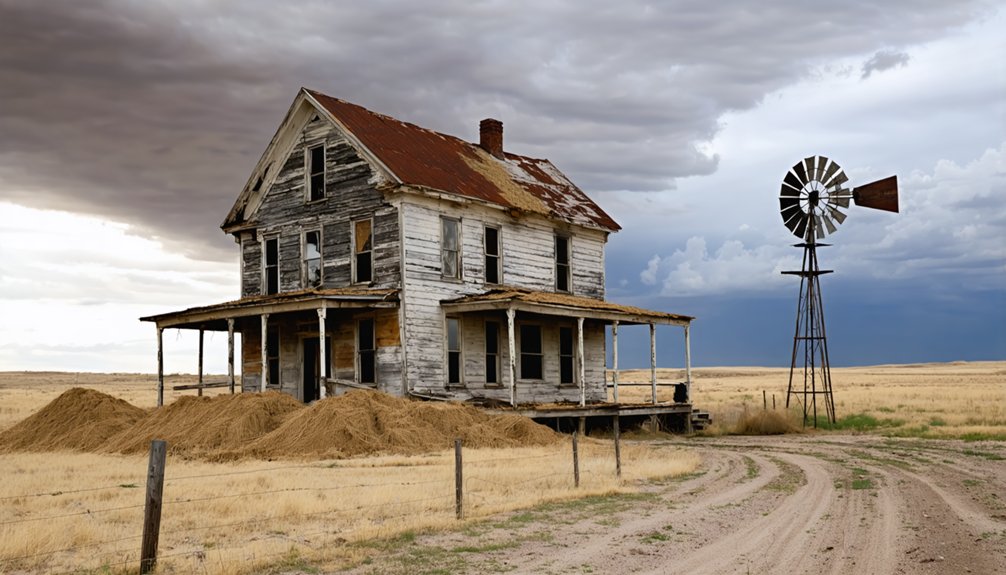
While specific natural disasters affecting Luffman remain largely undocumented, you’ll find the town faced typical environmental challenges of South Dakota’s Prairie Coteau region.
Like other settlements in Marshall County, Luffman’s residents likely battled fierce blizzards that cut off supply routes and prairie fires that threatened crops and property.
You’ll see patterns of harsh winters, periodic flooding, and devastating droughts that tested the community’s resilience.
Though no catastrophic single event stands out in historical records, the cumulative impact of these natural disasters and environmental challenges probably contributed to Luffman’s decline.
While no single disaster sealed Luffman’s fate, years of environmental hardships slowly eroded the town’s foundation.
The town’s story mirrors many rural South Dakota communities where residents gradually moved away, driven by the combined pressures of severe weather, agricultural hardships, and changing economic conditions.
The Chapel’s Enduring Legacy
Beyond the environmental challenges that tested Luffman’s resilience, the town’s chapel stood as a beacon of hope and community spirit.
The chapel’s significance extended far beyond its spiritual role, serving as a central gathering place where you’d find neighbors celebrating weddings, mourning at funerals, and uniting for harvest festivals. The foot pump organ discovered in the old schoolhouse brought music to the congregation’s services.
Today, while the structure may stand in disrepair, its legacy continues to echo through South Dakota’s historical narrative.
The chapel exemplified community resilience during frontier life, providing both spiritual guidance and social connection.
You can still sense its impact in the cultural identity of the region, where local legends and memories preserve the story of a place that symbolized hope in the face of adversity.
Despite Luffman’s eventual decline, the chapel remains a symbol of pioneering determination.
Tales From the Cemetery
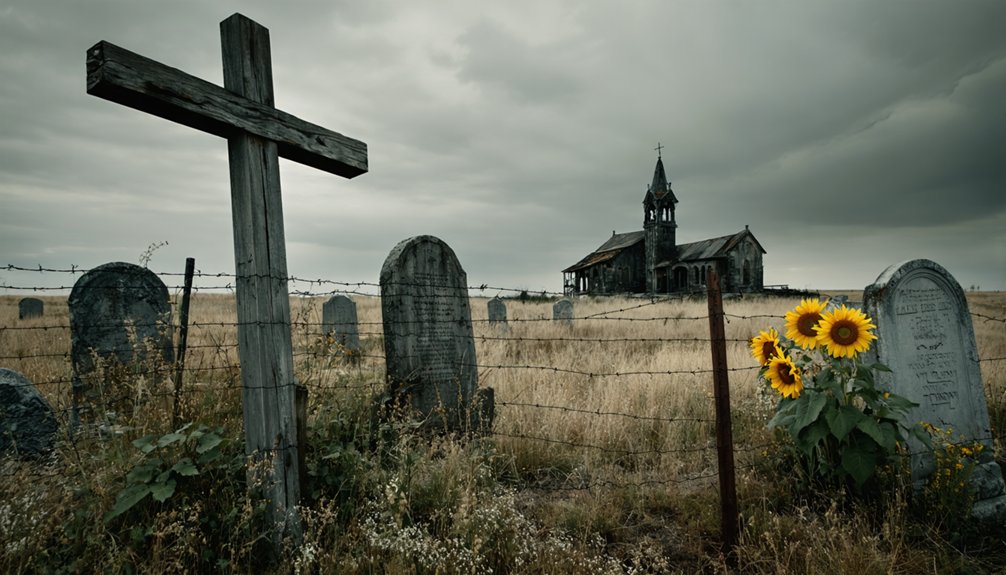
Standing quietly at the edge of town, Luffman’s cemetery tells silent stories of frontier life through its weathered markers and unmarked graves.
You’ll find poignant reminders of the harsh realities faced by early settlers – crude wooden crosses, fieldstone markers, and small cribs marking children’s graves. Local legends speak of spooky encounters near unmarked plots, where simple sticks once identified final resting places of miners, Civil War veterans, and frontier families.
Disease, mining accidents, and violence claimed many lives here, reflected in brief epitaphs that hint at personal tragedies.
While some graves have been restored by dedicated volunteers, others remain mysteries, their stories lost to time.
Today, you might spot history enthusiasts carefully documenting what remains, working to preserve these precious glimpses into Luffman’s past.
Walking the Ghost Town Today
As you venture into Luffman today, you’ll find yourself traversing rough terrain typical of South Dakota ghost towns, with minimal remnants of the original settlement visible across the open landscape.
Your ghost town exploration requires careful hiking preparation, as there aren’t any marked trails or visitor facilities at the site. You’ll need to navigate using old maps and bring essential supplies for remote conditions.
Watch for scattered foundations, ash heaps, and traces of past habitation as you walk the area. Be mindful of private property boundaries and potential mining claims nearby.
While wildlife like deer may cross your path, they pose little risk if you maintain standard outdoor precautions. Weather conditions greatly impact accessibility, so check forecasts and inform others of your plans before setting out.
Economic Rise and Fall
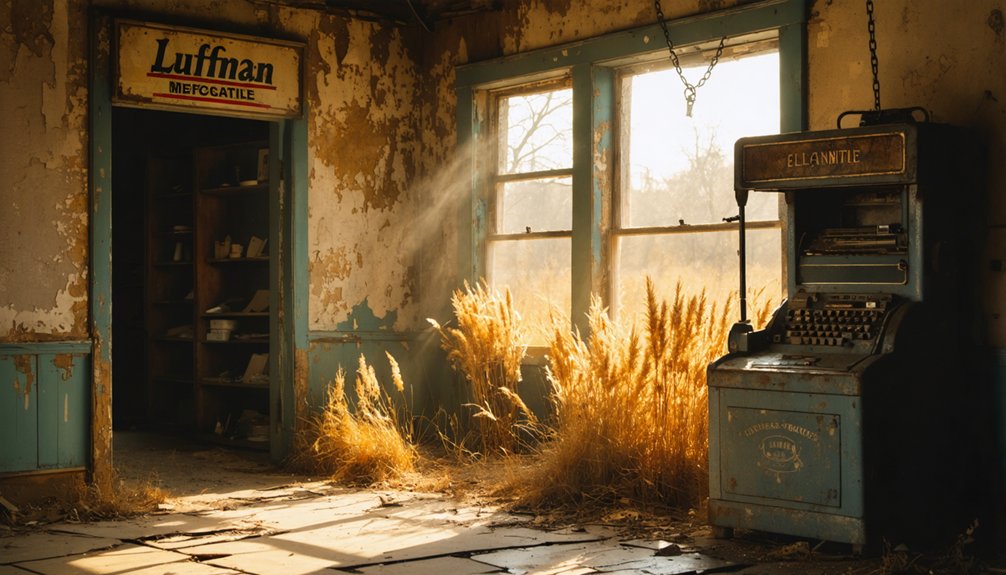
While Luffman’s economic story began modestly in southeast Marshall County, the town’s fortunes centered around its crucial sawmill operation that employed most of the roughly 100 residents during its peak.
You’ll find that railroad connections enhanced the town’s economic resilience, enabling timber transport and sustaining local commerce.
- Resource management challenges emerged as timber supplies dwindled
- The 1952 sawmill closure eliminated the primary source of employment
- Loss of railroad service isolated the community from critical markets
- Periodic flooding further destabilized the local economy
Preserving Luffman’s Story
The preservation of Luffman’s history now rests in the dedicated efforts of multiple organizations and individuals.
You’ll find the South Dakota State Historical Society at the forefront, safeguarding essential records, maps, and census data that tell Luffman’s story. Community involvement plays a significant role through local historical societies and museums that organize exhibitions and preservation events.
Digital preservation efforts have revolutionized how you can access Luffman’s past. Through online databases, virtual tours, and 3D modeling, you’re able to explore the town’s heritage remotely.
Physical preservation focuses on protecting remaining structures, while interpretive signage and guided tours help you understand the site’s significance. Photography projects document the current condition of structures, creating a visual timeline that’ll help future generations appreciate Luffman’s place in South Dakota’s history.
Black Hills Ghost Town Heritage
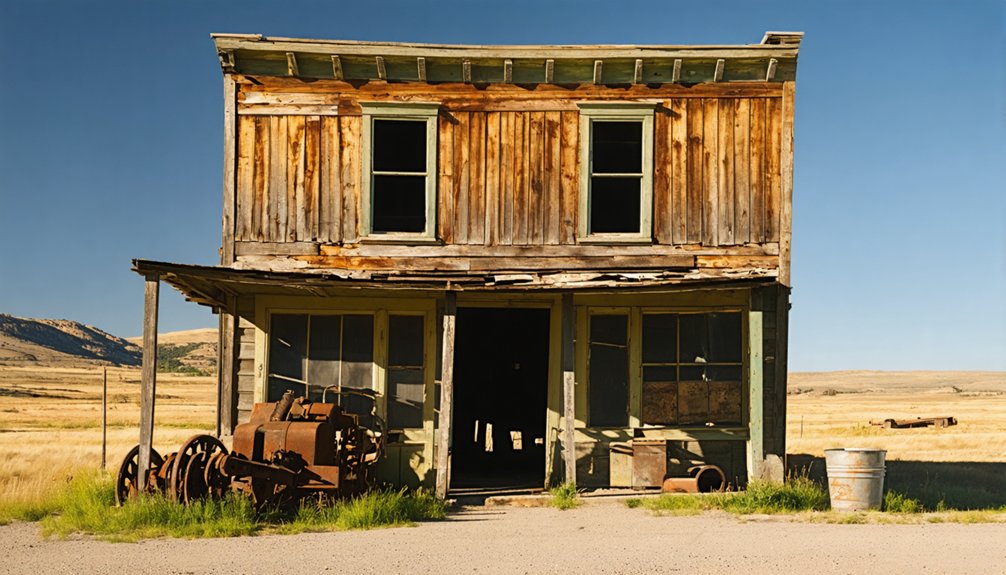
Deep within South Dakota’s Black Hills, you’ll discover a network of ghost towns that tell compelling stories of boom-and-bust cycles from the 1870s gold rush era.
These silent settlements, including Luffman, represent a crucial chapter in America’s westward expansion, where ghost town folklore and historical preservation efforts keep frontier memories alive.
- Mining camps turned ghost towns showcase the region’s rich mineral heritage, from gold rushes to coal extraction.
- Notable figures like Wild Bill Hickok and Calamity Jane walked these streets, leaving lasting legends.
- Railroad intersections and stage stations reveal how transportation shaped these communities.
- Preserved ruins and structures stand as evidence of pioneer life, though many face ongoing preservation challenges.
These remnants of frontier life continue drawing visitors who seek authentic connections to the Wild West’s untamed spirit.
Frequently Asked Questions
Are There Any Documented Paranormal Activities or Ghost Sightings in Luffman?
You won’t find documented ghost encounters or spectral history in official records. Despite the town’s abandoned status, there’s no credible evidence of paranormal activity reported from this location.
What Was the Average House Price in Luffman During Its Peak Years?
You won’t find documented average housing prices for Luffman’s peak years, though economic decline after 1952 suggests modest values typical of rural sawmill towns – likely equivalent to a few thousand modern dollars.
Did Any Famous People or Notorious Criminals Ever Visit Luffman?
Like a blank canvas untouched by fame, you won’t find any famous visitors or criminal history in Luffman’s past. No evidence exists of notorious figures ever passing through this remote settlement.
What Native American Tribes Originally Inhabited the Luffman Area Before Settlement?
You’ll find that Paleo-Indians first inhabited the area 10,000 years ago, followed by Mandan and Arikara peoples. Later, Lakota culture and Dakota history dominated when Sioux tribes moved into the region by 1700s.
Were There Any Major Crimes or Significant Law Enforcement Events in Luffman?
You won’t find documented evidence of major crimes or significant law enforcement events in Luffman’s history. Historical records and archives don’t reveal any notable criminal activity in this Black Hills settlement.
References
- https://www.youtube.com/watch?v=_0WNYsFLSLA
- https://www.sdhspress.com/journal/south-dakota-history-2-2/some-black-hills-ghost-towns-and-their-origins/vol-02-no-2-some-black-hills-ghost-towns-and-their-origins.pdf
- https://www.sdpb.org/rural-life-and-history/2023-08-21/some-black-hills-ghost-towns-and-their-origins
- https://core.ac.uk/download/pdf/345016075.pdf
- https://www.powderhouselodge.com/black-hills-attractions/fun-attractions/ghost-towns-of-western-south-dakota/
- https://www.blackhillsbadlands.com/blog/post/old-west-legends-mines-ghost-towns-route-reimagined/
- https://en.wikipedia.org/wiki/List_of_ghost_towns_in_South_Dakota
- https://icatchshadows.com/okaton-and-cottonwood-a-photographic-visit-to-two-south-dakota-ghost-towns/
- https://www.youtube.com/watch?v=xtVV4Kg2UlE
- https://commons.und.edu/cgi/viewcontent.cgi?filename=10&article=1000&context=oers&type=additional
